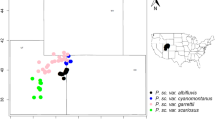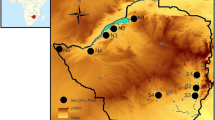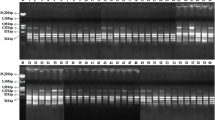Abstract
Ranunculus cabrerensis is an endemic and endangered species of the Northwestern Iberian Peninsula. The molecular markers AFLP and ISSR were used to investigate the genetic diversity and population structure of four populations across its known distribution. Fifteen selective primer combinations of AFLP and seventeen ISSR primer combinations produced a total of 2830 and 103 unambiguously repeatable fragments respectively, of which 97.57 and 81.38% were polymorphic for both markers. The genetic diversity of R. cabrerensis at species level was high (H E = 0.294 by ISSR and H E = 0.191 by AFLP) and differentiation between sampled locations was also relatively high (G ST = 0.316 and 0.158 by ISSR and AFLP analysis respectively) compared to other studies of endangered and rare species using the same techniques. The analysis of molecular variance (AMOVA) indicated that the main genetic variation was within sampled locations (73% by AFLP; 52% by ISSR), even though the variation among locations was also significant. Principal Coordinates, NeighborNet and Bayesian analyses revealed a weak but significant relationship between the genetic structures of different populations in R. cabrerensis, with gene flow acting as a homogenizing force that prevents stronger differentiation of populations. Finally, suggestions for conservation strategies to preserve the genetic resources of this species are outlined.
Similar content being viewed by others
References
Bañares A., Blanca G., Güemes J., Moreno J.C. & Ortíz S. (eds). 2004. Atlas y libro rojo de la flora vascular amenazada de Espańa. Dirección General de la Conservación de la Naturaleza, Madrid.
Barnaud A. & Houliston G.J. 2010. Population genetics of the threatened tree daisy Olearia gardneri (Asteraceae), conservation of a critically endangered species. Conserv. Genet. 11: 1515–1522.
Bellusci F., Palermo A.M., Pellegrino G. & Musacchio A. 2008. Genetic diversity and spatial structure in the rare, endemic orophyte Campanula pseudostenocodon Lac. (Apennines, Italy), as inferred from nuclear and chloroplast variation. Plant Biosys. 142: 24–29.
Bueno Sánchez A., Fernández Casado M.A. & Fernández Prieto J.A. 1992. A new subspecies of Ranunculus parnassiifolius L. (Ranunculaceae) from the Cantabrian Mountains, Spain. Bot. J. Linean Soc. 109: 359–367.
Buza L., Young A. & Thrall P. 2000. Genetic erosion, inbreeding and reduced fitness in fragmented populations of the endanged tetraploid pea Swainsonia recta. Biol. Cons. 93: 177–186.
Chen Y.-Y., Liao L., Wei L. & Zuo-Zhou L. 2010. Genetic diversity and population structure of the endangered alpine quillwort Isoetes hypsophila Hand.-Mazz. revealed by AFLP markers. Pl. Syst. Evol. 290: 127–139.
Ci X.-Q., Chen J.-Q., Li Q.-M. & Li J. 2008. AFLP and ISSR analysis reveals high genetic variation and inter-population differentiation in fragmented populations of the endangered Litsea szemaois (Lauraceae) from Southwest China. Pl. Syst. Evol. 273: 237–246.
Cires E. 2011. Unravelling the polyploid complex Ranunculus parnassiifolius L. (Ranunculaceae): A combined morphologic and molecular-genetic approach. PhD dissertation, Universidad de Oviedo, 212 pp.
Cires E. & Fernández Prieto J.A. 2012. The Iberian endemic species Ranunculus cabrerensis Rothm.: an intricate history in the Ranunculus parnassiifolius L. polyploid complex. Pl. Syst. Evol. 298: 121–138.
Cires E., Samain M.-S., Goetghebeur P. & Fernández Prieto J.A. 2011. Genetic structure in peripheral Western European populations of the endangered species Cochlearia pyrenaica (Brassicaceae). Pl. Syst. Evol. 297: 75–85.
Cuesta C., Ordás R., Rodríguez A. & Fernández B. 2010. PCRbased molecular markers for assessment of somaclonal variation in Pinus pinea clones micropropagated in vitro. Biol. Plantarum 54(3): 435–442.
Doyle J.J. & Doyle J.L. 1987. A rapid DNA isolation procedure for small quantities of fresh leaf tissue. Phytochem. Bull. 19: 11–15.
Ellstrand N.C. & Elam D.R. 1993. Population genetic consequences of small population size: implications for plant conservation. Annu. Rev. Ecol. Syst. 24: 217–243.
Evanno G., Regnaut S. & Goudet J. 2005. Detecting the number of clusters of individuals using the software STRUCTURE: a simulation study. Mol. Ecol. 14: 2611–2620.
Falush D., Stephens M. & Pritchard J.K. 2007. Inference of population structure using multilocus genotype data: dominant markers and null alleles. Mol. Ecol. Notes 7: 574–578.
Fernández Prieto J.A., Díaz González T.E. & Nava Fernández H.S. 2007. La protección de la flora vascular del Principado de Asturias. Naturalia Cantabricae 3: 37–56.
Fischer M. & Matthies D. 1998. RAPD variation in relation to population size and plant fitness in the rare Gentianella germanica (Gentianaceae). Am. J. Bot. 85: 811–819.
Frankham R., Ballou J.D. & Briscoe D.A. 2004. Introduction to conservation genetics. Cambridge University Press, Cambridge.
Gaudeul M., Taberlet P. & Till-Bottraud I. 2000. Genetic diversity in an endangered plant, Eryngium alpinum L. (Apiaceae), inferred from amplified fragment length polymorphism markers. Mol. Ecol. 9: 1625–1637.
Gliddon C. & Goudet J. 1994. The genetic structure of metapopulations and conservation biology, pp. 107–114. In: Loeschke V., Tomiuk J. & Jain S.K. (eds), Conservation genetics. Birkhäuser, Basel.
Gong W., Gu L. & Zhang D. 2010. Low genetic diversity and high genetic divergence caused by inbreeding and geographical isolation in the populations of endangered species Loropetalum subcordatum (Hamamelidaceae) endemic to China. Conserv. Genet. 11(6): 2281–2288.
González-Pérez M.A., Sosa P.A. & Batista F.J. 2009. Genetic variation and conservation of the endangered endemic Anagyris latifolia Brouss. ex Willd. (Leguminosae) from the Canary Islands. Pl. Syst. Evol. 279: 59–68.
Hammer Ø., Harper D.A.T. & Ryan P.D. 2001. PAST: paleontological statistics software package for education and data analysis. Palaeontol. Electronica 4: 1–9.
Hamrick J.L. & Godt M.J.W. 1996. Effects of life history traits on genetic diversity in plant species. Phil. Trans. R. Soc. Lond. B 351: 1291–1298.
Hamrick J.L., Godt M.J.W., Murawshi D.A. & Loveless M.D. 1991. Correlations between species traits and allozyme diversity: implications for conservation biology, pp. 75–86. In: Falk D.A. & Holsinger K.E. (eds), Genetics and conservation of rare plants. Oxford University Press, New York.
Höglund J. 2009. Evolutionary conservation genetics. Oxford University Press, Oxford, 189 pp.
Huson D.H. & Bryant D. 2006. Application of phylogenetic networks in evolutionary studies. Mol. Biol. Evol. 23: 254–267.
Jeong J.H., Kim E.H., Guo W., Yoo K.O., Jo D.G. & Kim Z.S. 2010. Genetic diversity and structure of the endangered species Megaleranthis saniculifolia in Korea as revealed by allozyme and ISSR markers. Pl. Syst. Evol. 289: 67–76.
Jones C.J., Edwards K.J., Castaglione S., Winfield M.O., Sale F., Van de Wiel C., Bredemeijer G., Buiatti M., Maestri E., Malcevshi A., Marmiroli N., Aert R., Volckaert G., Rueda J., Linacero R., Vazquez A. & Karp A. 1997. Reproducibility testing of RAPD, AFLP and SSR markers in plants by a network of European laboratories. Mol. Breed. 3: 381–390.
Li J. & Jin Z. 2007. Genetic variation and differentiation in Torreya jackii Chun, an endangered plant endemic to China. Plant Sci. 172: 1048–1053.
Llamas F., Acedo C., Lence C., Alonso R., Molina A. & Castro V. 2007. —Flora cantábrica de interés en Castilla y León. Naturalia Cantabricae 3: 57–78.
Manni F., Guérard E. & Heyer E. 2004. Geographic patterns of genetic, morphologic, linguistic variation: how barriers can be detected by “Monmonier’s algorithm”. Human Biol. 76: 173–190.
Moreno J.C. (coord.) 2008. Lista roja 2008 de la flora vascular espańola. Dirección General de Medio Natural y Política Forestal (Ministerio de Medio Ambiente, y Medio Rural y Marino, y Sociedad Espańola de Biología de la Conservación de Plantas), Madrid, 86 pp.
Neel M.C. & Ellstrand N.C. 2003. Conservation of genetic diversity in the endangered plant Erigonum ovalifolium var. vineum (Polygonaceae). Conserv. Genet. 4: 337–352.
Nei M. 1972. Genetic distance between populations. Amer. Nat. 106: 283–392.
Nei M. 1977. F-statistics and analysis of gene diversity in subdivided populations. Ann. Hum. Genet. 41: 225–233.
Nybom H. 2004. Comparison of different nuclear DNA markers for estimating intraspecific genetic diversity in plants. Mol. Ecol. 13: 1143–1155.
Peakall R. & Smouse P.E. 2006. GENALEX 6: genetic analysis in Excel. Population genetic software for teaching and research. Mol. Ecol. Notes 6: 288–295.
Pritchard J.K., Stephens M. & Donnelly P. 2000. Inference of population structure using multilocus genotype data. Genetics 155: 945–959.
Qiu Y.-Y., Hong D.-H. & Fu C.-X. 2004. Genetic variation in the endangered and endemic species Changium smyrnioides (Apiaceae). Biochem. Sys. Ecol. 32: 583–596.
Rottenberg A. & Parker J. 2003. Conservation of the critically endangered Rumex rothschildianus as implied from AFLP diversity. Biol. Cons. 114: 299–303.
Shao J.W., Chen W.L., Peng Y.Q., Zhu G.P. & Zhang X.P. 2009. Genetic diversity within and among populations of the endangered and endemic species Primula merrilliana in China. Biochem. Sys. Ecol. 37: 699–706.
Slatkin M. 1994. Gene flow and population structure, pp. 3–17. In: Real L.A. (ed.), Ecological genetics. Princeton University Press, New Jersey.
Slatkin M. 1987. Gene flow and the geographic structure of natural populations. Science 236: 778–792.
Slatkin M. & Barton N.H. 1989. A comparison of three indirect methods for estimating average levels of gene flow. Evolution 43: 1349–1368.
Smith T.B. & Wayne R.K. 1996. Molecular genetic approaches in conservation. Oxford University Press, Oxford, 483 pp.
Sosa P., Batista F.J., González M.A. & Bouza N. 2002. La conservación genética de las especies vegetales amenazadas, pp. 133–160. In: Bañares Baudet á. (coord.), Biología de la conservación de plantas amenazadas. Técnicas para el diagnóstico del estado de conservación. Organismo Autónomo de Parques Nacionales. Ministerio de Medio Ambiente, Madrid.
Tomimatsu H. & Ohara M. 2003. Genetic diversity and local population structure of fragmentation of Trillium camschatcense. Biol. Cons. 109: 249–258.
Travis S.E., Maschinski J. & Keim P. 1996. An analysis of genetic variation in Astragalus cremnophylax var. cremnophylax, a critically endangered plant, using AFLP markers. Mol. Ecol. 5: 735–745.
Vekemans X. 2002. AFLP-SURV. Laboratoire de Génétique et Ecologie Végétale, Université libre de Bruxelles, Bruxelles, Belgium.
Vos P., Hogers R., Bleeker M., Reijand M., van de Lee T., Hornes M., Frijers A., Pot J., Peleman J., Kuiper M. & Zabeau M. 1995. AFLP: a new technique for DNA fingerprinting. Nucleic Acids Res. 23: 4407–4414.
VV AA. 2000. Lista roja de la flora vascular espańola (valoración según categorías UICN). Conservación Vegetal 6(extra): 1–39.
Wu C.-J., Cheng Z.-Q., Huang X.-Q., Yin S.-H., Cao K.-M. & Sun C.-R. 2004. Genetic diversity among and within populations of Oryza granulata from Yunnan of China revealed by RAPD and ISSR markers: implications for conservation of the endangered species. Plant Sci. 167: 35–42.
Xiao L.Q., Ge X.J., Gong X., Hao G. & Zheng S.X. 2004. ISSR variation in the endemic and endangered plant Cycas guizhouensis (Cycadaceae). Ann. Bot. 94: 133–138.
Zhivotovsky L.A. 1999. Estimating population structure in diploids with multilocus dominant DNA markers. Mol. Ecol. 8: 907–913.
Zietkiewicz E., Rafalski A. & Labuda D. 1994. Genome fingerprinting by simple sequence repeat (SSR)-anchored polymerase chain reaction amplification. Genomics 20: 176–183.
Author information
Authors and Affiliations
Corresponding author
Rights and permissions
About this article
Cite this article
Cires, E., Cuesta, C. & Fernández Prieto, J.A. Genetic diversity and structure in fragmented populations of the endangered species Ranunculus cabrerensis (Ranunculaceae): implications for conservation. Biologia 68, 30–40 (2013). https://doi.org/10.2478/s11756-012-0126-6
Received:
Accepted:
Published:
Issue Date:
DOI: https://doi.org/10.2478/s11756-012-0126-6




